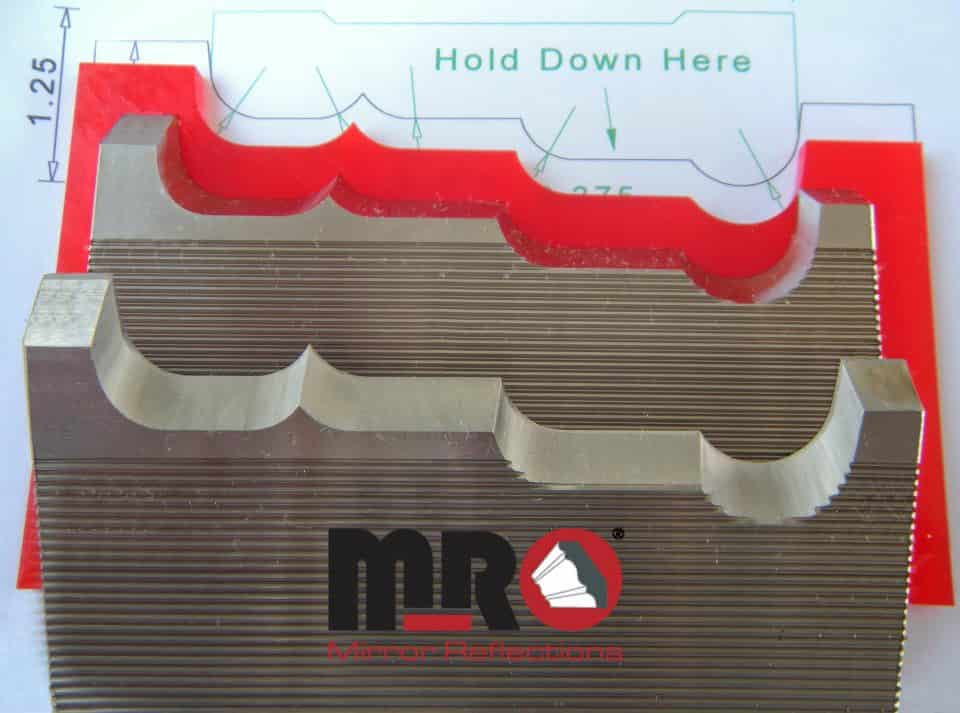This article will provide some safety tips, suggestions, causes and
solutions on how to by-pass moulding knife damage or breakage on
industrial moulder's while milling lumber.
Industrial molding knife damage occurs daily in our industry, it is an
unfortunate situation, but is more common than one would think, this
phenomenon will eventually materialize with all machine operators
throughout their careers.
Everyone's concern is the safety of the machine operator and others
around the milling operation; this reiterates the obligation that all
cutterhead guards, hoods, and other safety devices should always be in
there proper place and functioning throughout the service life of the
machinery.
Below are a couple of images of damaged knives we received for
sharpening. On the first pic, look where the pencil is pointing, it is
obvious these blades lightly struck one of two areas on the moulder,
either they came in contact with the left adjustable guide fence (most
likely), or the machines bedplates. What's notable is, we had the
knives designed the exact opposite before these cutters were
signed off, and manufactured, but
the business owner insisted we mill the thin portion of the profile
closest to the left outside edge on the machinery. We explained that
the blades could easily be damaged while milling, Mirror Reflections
has
designed and manufactured moulding knives
for over thirty years, but some people have no interest in useful information,
sometimes you cannot save people from themselves luckily no one got injured.

In the crown knives image, the blades struck multiple foreign objects
buried in the lumber, or end grain of the wood while milling. We will
refrain from speculating on how these knives were broken, in some
cases we just do not know.
We have compiled a list below of possible causes and solutions of
items that might contribute to possible knife fracture and breakage.
Your safety and health are our primary concern, it is your duty and
responsibility to abide by all safety practices set forth by your
employer and the manufacturer of your machinery.
Cause:
Moulding knives encountered
the bedplates, chip breakers, guide, or stationary fences while in operation.
Solution:
Rotate moulding knives
slowly by hand in reverse of normal rotation during setup. This procedure
will confirm cutters will clear all obstacles they may encounter during
milling. Perform a crash test on all chip breakers, chip deflectors,
and pressure elements with a 2x4 during set up, adjust cutting circle
if necessary. Proper knife design is essential in all profiles for this
to be problem free.
Cause:
Knots in the lumber may dislodge
while milling, they became projectiles striking the blade, which causes
fracturing, and or breakage.
Solution:
Possessing a small rubber
or hard plastic mallet would allow the machine operator to lightly tap
the knot or knots to assure oneself that these knots in the lumber would
proceed thru moulder and remain intact throughout the process.
Cause:
Moulder operator halted the
cutter head spindle motors prior to the machine’s feed system. Motor
spindle brakes stop the cutterhead spindles very quickly, if motor spindle
brakes activate while the feed system is in operation it could be the
origin of knife breakage, some newer models of moulder’s have safety
limits in place to avoid this action from occurring.
Solution:
Incorporate systematical
procedures for starting and stopping of the cutterhead spindles and feed
systems, all machine operators are required to obtain extensive training
in these guidelines.
Cause:
Machine operator neglected
to remove the lash or slop in the adjusting screw threaded rod on moulding
cutterheads during set up procedures. The probability exists that when
running a profile where the knives are close to the bedplates while operating,
slop or lash in top spindle adjusting screw threads will allow the knives
to encounter bedplates resulting in breakage of the cutters.
Solution:
While setting up moulder,
all final movements of moulder spindles should be toward the lumber except
the top spindles, this action will assure the operator that all lash
in adjusting screw threads was eliminated, it is commonly referred to
as the loop on CNC spindles. On the top horizontal spindle, set knives
horizontally during set up, this procedure will eliminate the possibility
of the knives encountering the bedplates or guide fences when removing
lash from top spindle adjusting screw.
Cause:
Moulder operator started moulding
machine with woodwork piece already in moulder, overlooking manual hand
spinning heads in reverse of normal rotation prior to exclude any tension
that might occur on work piece before starting.
Solution:
If the moulder was shut
down with lumber still in machine, while in the off position, manually
release spindle brakes if applicable, check spindle rotation by hand,
in reverse of normal rotation to assure cutter head is capable to spin
freely when spindle motor is activated.
Cause:
The operator placed the machine
under full workload before the machine had a chance to reach full rpm’s
causing excessive stress on knives, even breakage.
Solution:
Most new style moulders
that utilize flat belts on spindles and motor pulleys have soft start
motors. Soft start is a two-stage start up procedure to achieve full
rpms and keep the belts from burning or breaking during startup. Soft
start motor stages are controlled by timers in the electrical cabinet,
give the moulder about 15-20 seconds after starting, this time allows
for the second timer to engage giving full rpm’s power to the motor,
eliminating the opportunity for moulding knife breakage.
Cause:
Improper machine set up techniques;
fences, chip breakers, and guides tightly adjusted, feed system not properly
fine-tuned for thickness of lumber, this causes feeding issues. Whacking
the ends of boards against one another to get the lumber to advance through
moulder feed system will increase probability of breaking the knives
quickly.
Solution:
A firm setup is fine,
the tighter the setup the more friction and increased pressure on the
feed system, the feed system should be set at the finish thickness size.
Proper training will eliminate most feeding problems for moulding machine
operators.
Cause:
Improper cooling of the high
speed knife steel after cutting, and while grinding can cause fracturing
of the tool leading to breaking upon using the knives please refer to
our article on
aligning moulder knives in the cutterhead.
Solution:
Do not submerge knives
in cold water after cutting to length; let the knife blanks cool at room
temperature, the sudden change can cause the knife to fracture without
you even realizing it. Use enough coolant from the face (smooth side)
of the knife while profile grinding. Burn marks on the face side of the
knife steel indicate burning of the tool, this makes the blade fragile,
the brittle the knife steel, the easier it is to break.
Cause:
Dull knives, the spindle motor
will generally always force the blades to cut, but if the knife is dull
it will build up heat, initiate finish issues, and eventually fracture
leading to machine damage.
Solution:
This is an easy fix;
keep your moulding knives sharp!
Cause:
Improper steel size, we always
supply you with the correct steel height sizes on all our profile cad
drawings, if you routinely use a bigger size steel to make it last longer,
you are only increasing the size of your cutting circle, this can lead
to knife breakage from unsupported lumber while machining.

We have provided you with some especially important information about
high speed steel and carbide cutters, and some reasons for failure
during manufacturing and milling of lumber. Although we may not have
covered all the reasons for knife failure, these solutions will solve
many issues. A highly skilled, experienced machine operator with
formal training can significantly reduce the possibility of the
concerns expressed in this article. We also recommend reading our
article on
production tips
for moulder operators for moulder operators to eliminate concerns not discussed
in this article. If we can be of any further support, please,
contact us
.







